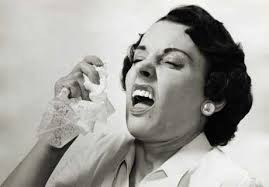 It’s that time of year again — when many of us find ourselves sneezing and blowing as the flowers and grasses bloom. It’s important to remember, before you rush to the drug store, that homeopathy might be the answer you really need.
It’s that time of year again — when many of us find ourselves sneezing and blowing as the flowers and grasses bloom. It’s important to remember, before you rush to the drug store, that homeopathy might be the answer you really need.
Many years ago, before I used homeopathy, my spring and summer allergies were pretty bad and getting worse. I was beginning to resort to allergy medicines and nasal sprays — all merely suppressive and, I know now, likely to make my overall health and even my allergies worse. My spring sneezing, congestion, and worst of all, itchy palate, improved dramatically and immediately after I began homeopathic treatment with a good constitutional remedy. In fact, this amelioration of my allergies was one of my first personal striking experiences of the power of homeopathy.
Since allergic reactions are really broad constitutional symptoms of the body, treatment with a good constitutional remedy — addressing all the symptoms of the entire symptom complex: emotional, mental, and physical — is usually the best and most deeply curative approach to allergy treatment. Indeed, the remedy that helped me with my allergies was by no means one would think of for the treatment of allergies. But it helped me and my vital force, which then helped me to be less susceptible to allergens and able to react to them in a more balanced manner.
That said, there are more targeted approaches to allergy treatment that do work — in fact, scientific studies have repeatedly proven that they work. In general, the approach is to give the offending allergen (for example, pollen), in a potentized, highly dilute dose. The approach is called “isopathy”. Remember, there is not even a molecule of the allergen in the remedy, it is merely the energy of the allergen.
While many liken the use of homeopathy to the allopathic use of allergy shots (which directly inject diluted material doses of the allergen, along with who-knows-what toxic adjuvants, directly into the body tissues), the homeopathic approach is safe and non-invasive. Still, the success of allergy shots is testimony to the fact that even the crudest and most toxic application of the homeopathic principle can be effective at some level.
Two studies of the isopathic use of allergens in potency were described in my book Impossible Cure. Both were conducted by Scottish homeopathy David Reilly, MD.
1. “David Reilly, MD, and colleagues in Glasgow performed a double-blind controlled trial of a 30c potency of house dust mite, given to dust-allergy sufferers. In the homeopathic group 77% showed an improvement compared to only 33% showing an improvement with placebo. The study was supervised by a consulting respiratory physician who recruited the patients for the study.” [Reilly, D., M. Taylor, N. Beattie, et al., “Is Evidence for Homoeopathy Reproducible?” Lancet, 344, p. 1601–1606 (December 10, 1994)]
2. “In the summer of 2000, another allergy study by Reilly and his colleagues at the Glasgow Homeopathic Hospital was published in the British Medical Journal. 50 patients were treated with a homeopathic preparation or with placebo, and were measured daily for nasal air flow. Those on homeopathic treatment had 28% improved nasal air flow over the course of four weeks, compared with just 3% improvement in the placebo group.” [Taylor, Morag A., David Reilly, Robert H. Llewellyn-Jones, Charles McSharry, and Tom C. Aitchison, “Randomised Controlled Trial of Homoeopathy Versus Placebo in Perennial Allergic Rhinitis with Overview of Four Trial Series,” British Medical Journal (BMJ), 321, pp. 471–476 (August 19, 2000)]
In addition to the isopathic approach, there is also the more traditional and somewhat more palliative approach of using remedies that are specifically associated with the common symptoms of allergies — runny nose, stuffiness, sneezing, etc. These are usually the components of homeopathic “allergy” remedies sold in health food stores, usually containing mixtures of low potencies of the various matching remedies. Typical remedies of this kind include:
▪ Allium cepa — Burning discharge from nose, bland discharge from eyes, pricking sensation in larynx.
▪ Euphrasia — Eyes swollen with thick, burning discharge, bland discharge from nose, coughing up phlegm, feels worse indoors.
▪ Sabadilla — Violent sneezing, itchy nose, red, and swollen eyelids, runny eyes, headache as if head is shrinking.
So please remember: if you embark on a sneeze-fest this summer, homeopathy might be your answer. If you are skeptical, try out an over-the-counter homeopathic allergy medicine and see if you find a little relief. But even if that doesn’t help much, remember that the best and deepest approach is to see a classical homeopath and have your full case taken. You can find referral information on the Impossible Cure website.
Before I conclude, I thought I’d give you one more tip — only loosely homeopathic — that might be helpful. Although my allergies improved 95% when I first began to use homeopathy, I have noticed that they’ve crept back a bit over the past few years. This spring, however, I’ve had NONE — not a single sneeze — and it has been a bad season for many. One explanation may be that I’ve been on a new constitutional remedy and it seems to be acting deeply for me.
Another intriguing possibility is that, over the past month, I’ve been experimenting with eating local “weeds”. There is a movement afoot that I’m very interested in — foraging — that is educating people about the healthy and highly edible nature of many of the local plants growing wild all around us. For example, check out this article in, of all places, Good Housekeeping.
About a month ago, I began plucking bright yellow dandelion heads in my neighborhood and frying them up in a bit of olive oil. I know this may sound a bit strange, but they are loaded with vitamin C and lots of other good things. Dandelion tea is also known for also helping with spring allergies, probably because they carry the pollen of the local plants. Like cures like! You know your fried dandelion heads are ready to eat when they turn brown and start smelling a bit nutty. They taste like a slightly bitter nut and I’ve become a big fan. Try it out! (Though begin with just one or two to test your reaction.) You might find that the “potentized” dose of pollen supplied by these cheerful little friends growing all around us might be just the medicine you need!






0 Comments